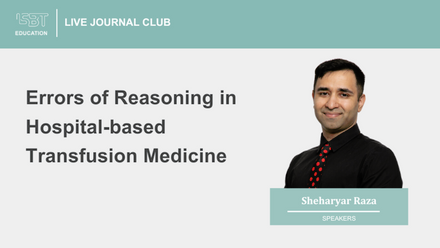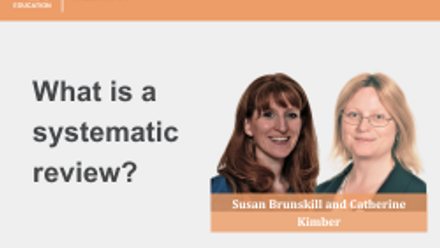The Change management - evidence based decisions session included the following presentations:
1. Barbee Whitaker: Modeling the Effect of an Individual-Risk Based Deferral Policy for Sexual Behaviors on Blood Donations in the US
2. Rachel Thorpe: Understanding preferences for advancing inclusion of trans and gender diverse people in blood donation in Australia
3. Stephen Thomas: Safety profile of plasma for fractionation donated in the United Kingdom, with respect to variant Creutzfeldt-Jakob Disease
4. Antoine Lewin: Risk of variant Creutzfeldt-Jakob Disease for the Canadian Blood Supply
5. Veronica Hoad: Is Dual Testing for hepatitis C necessary? Risk Modelling and Cost Effectiveness of removing hepatitis C antibody testing for Australian blood donors
6. Jennie Haw: Advancing inclusivity and equity for trans, nonbinary, Two-Spirit and other gender-diverse donors
MODERATORS: Eric Jansen and Marja-Kaisa Auvinen
After the presentation, there was a questions and answers session of about 5 minutes, which is also included in the recording.
Abstract
Understanding preferences for advancing inclusion of trans and gender diverse people in blood donation in Australia
R Thorpe1,2, K Jensen3, B Masser3,4, B Haire5, H Yang6, P Bentley7
1Clinical Services and Research, Australian Red Cross Lifeblood, 2School of Population and Global Health, University of Melbourne, Melbourne, 3Clinical Services and Research, Australian Red Cross Lifeblood, 4School of Psychology, The University of Queensland, Brisbane, 5Kirby Institute, University of New South Wales, 6Clinical Services and Research, Australian Red Cross Lifeblood, Sydney, 7Clinical Services and Research, Australian Red Cross Lifeblood, Perth, Australia
Background: Australian Red Cross Lifeblood is working to advance inclusion of trans and gender diverse (TGD) people in blood donation. Currently blood collection agencies, including Lifeblood, experience challenges in adapting their systems and processes to be inclusive of TGD people, including limitations of donor registration software to binary gender options; how questions about sex and gender identity are asked and recorded; which donor screening questions are asked and how eligibility to donate is managed.
Local data about the experiences of TGD donors is lacking and is needed to optimise Lifeblood policies and procedures. For example, at Lifeblood, donors can register with their preferred gender, and this can be self-reported, however sex at birth is not collected. Further, TGD donors who report sex with a male, trans or gender diverse partner are deferred for 3-months.
To ensure findings addressed experiences and concerns of community members, we established a stakeholder group to inform research focus and design.
Aims: To work with stakeholders to understand issues on TGD blood donation and inform research.
To understand the perspectives and experiences of TGD people who have interest in donating, have attempted donating or who have donated blood.
To propose recommendations based on stakeholder feedback and interview findings.
Methods: Following ethical approval from Lifeblood, nine stakeholder group members were recruited through community groups, donor feedback and donor centre staff.
Interview participants were recruited through social media. 34 expressed interest and semi-structured interviews were completed with 14 people. Of these 11 were current/past donors and 3 non-donors. Interviews followed a journey-mapping approach.
Interviews were recorded, transcribed and analysed using thematic analysis.
Results: Stakeholders identified barriers for TGD people at each stage of donor recruitment and the pre-donation process. These data informed the interview guide.
Registration
Interviewees expressed a preference for separate fields to capture sex assigned at birth and current gender identity, and for gender identity to include transgender man, transgender woman and non-binary, as a minimum. They felt this information would improve processes for assessing product use and criteria for haemoglobin and total blood volume, and capture non-binary people in the donor database. Participants recommended explaining why sex assigned at birth was being asked, as this information may be sensitive.
Donor questionnaire
Participants suggested introducing the capability for donors to record preferred pronouns and name. Further, they indicated that the donor questionnaire should only ask what is necessary for blood donation, omitting titles or binary gendered language. These changes were perceived to reduce the risk of incorrect pronouns, names or inappropriately gendered language being used. Participants recommended changing how recent pregnancy is asked about to be inclusive.
Assessing eligibility
All participants thought that eligibility to donate blood should be based on sexual behaviour rather than gender identity, as behaviour was perceived to more accurately capture risk. Adopting an individual risk assessment approach was broadly supported.
Other
Non-donor and past-donor participants identified deterrents including: fear of incorrect name being used, uncertainty about procedures, and eligibility criteria. Participants suggested including more information on the website about procedures and to let TGD people know they are welcome to donate.
Summary/Conclusions: Our study identified several options to improve inclusion of TGD people in blood donation in Australia. We continue to work with stakeholders to develop recommendations for implementing our findings into operational practice.




